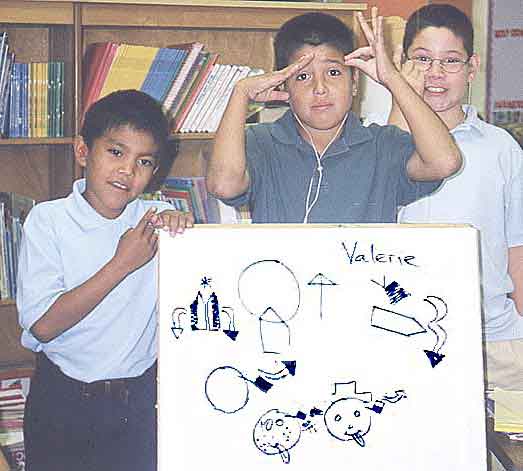Silent News, November 1999
page 2
Implementing SignWriting
Into Education
Cecilia Flood, a school counselor who works with 50 students
in small groups in two elementary school and one middle school
in Albuquerque, New Mexico, has been implementing SignWriting
into her curriculum for the past year. The quotes from the students
(above) were videotaped by her. When asked, "Have you been
told 'But SignWriting takes too much time in the classroom, and
we have to teach these students so much already'?", She
responded: "When I first approached classroom teachers about
this SignWriting project, (I heard comments such as) 'Oh, that's
too much to learn, I don't think this student will be able to
handle learning SignWriting as well as learning how to read English'....I
have gotten several responses from individual parents....These
concerns range from taking away time spent learning English,
to a concern that not enough members of the Deaf community use
SW, to a concern that SW will interfere with already developing
literacy skills".

Chaparral Elementary School
in Albuquerque, New Mexico
Left to right: The students, Danny, Fernando and Dathan.
They are demonstrating their name signs written in SignWriting.

Dealing with Resistence: Just Listen
Asked how she dealt with this, Flood replied: "My response...generally,
I don't respond. I just listen. I'm not trying to convince educators,
parents, or even Deaf community members that SignWriting is the
only way to go.
"I do believe that Deaf and hard of hearing students are
indeed smart enough and capable enough language users and learners
who can and do organize linguistic information into two separate
and distinct languages, ASL and English.
"My hope is that the ethnographic recording (that she is
currently doing) of Deaf and hard of hearing students' experiences
as they learn to write using SignWriting, will provide significant
evidence which will promote greater interest in the investigation
of a potential bi-literacy tool. That tool would be the use of
SW in bilingual education models for Deaf and hard of hearing
students in the U.S."
So Why Should We Use SignWriting
To Teach Deaf and Hard of Hearing Students?
Asked why Flood wanted to introduce SignWriting to her students,
this is her response:
"To capitalize on language abilities, not language problems.
To provide a medium, (SignWriting) that potentially may enhance
linguistic and cultural identity and self-empower Deaf and hard
of hearing students. "To record the experiential stories
of Deaf and hard of hearing SW learners that will significantly
inform perspectives on the academic literacy learning experiences
of Deaf and hard of hearing students,'in their own words'. "As
the lead instructor of SignWriting, I will attempt to neutralize
power relationships that exist in the everyday school literacy
learning environment and hope to promote shared power, one that
will encourage students and teachers to alternate between teacher
and learner roles." Having taught SignWriting for a year
now, Flood now recounted how quickly her students took to it:
...continued
page 3...
|